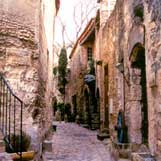Provence - Les Baux


Sights of Les Baux de Provence
Les Baux de Provence is unique among the many attractions in Provence. It is both an ancient ruin and a quaint much visited town. It perches for nearly a mile along a narrow strip of land jutting up from the valley floor, and surrounded on three sides by the sheer jagged cliffs of the Alpilles Mountain range.
The barons who once ruled much of Southern France resided in this strategic and formidable site. It is said that prisoners were forced to jump from the high cliffs if they could not pay their ransom. Whatever the case, the behavior of these barons became so outrageous that King Louis XIII turned against them. To stop their rule, he laid siege to the castle and destroyed it in 1632. Afterward the city sat almost deserted for several hundred years. Today, Les Baux is made up of two parts referred to as the "Live City" and the "Dead City".
Sights in the Live City of Les Baux
Vehicles are forbidden, so when you arrive at Les Baux you must park outside the "Live City", to walk the narrow lanes of this village that clings near the top of its white rock mountain. The village offers a few nice restaurants, small museums and a bundle of tourist shops.
One of the highlights of the New Town is Place St. Vincent, a shady town square surrounded by 16th - 17th century buildings. Notable among these are the Église St Vincent (church of St. Vincent) , Hôtel des Porceletes (contemporary art museum) and the Hôtel de Manville (Renaissance style town hall).
Also in the living city is the Chappelle des Pénitents-Blancs (Chapel of the White Penitents) with lovely wood carvings on display. The Penitents were brotherhoods, formed in the Middle Ages, that served as charitable organizations. Royalty and other noblemen would join these organizations to improve their public image and salve their own conscience. Each different group of Penitents adopted a different color habit and hood so as to be recognized. This chapel was built by the Penitents who wore white hoods.
The Yves Brayer Museum is also located in the live city. This museum is dedicated to the artist from the village who became famous for figurative paintings of Italy, Spain and bullfights.
Sights in the Dead City (Ville Morte) of Les Baux
A highlight of a visit to Les Baux is a stroll through the Dead City. Make your way through the village on its main street until you reach the entrance of the "Citadel" or the "Dead City". This ruined castle complex was carved from the living rock it stands on and dates back to 950 A.D.. The ruins you see today once housed over 6,000 people. On display are artifacts and massive weapons of the time. The high perches offer great views over the Val d'Enfer (Valley of Hell) and continue as far away as the Mediterranean. If you climb one of the towers (not advised in rain) you will also have wonderful views over the Live City of Les Baux. Late in the day the white rocks glow pink and gold from the setting sun. Winds can be extreme, and there will be signing at the entrance if extra caution is advised.
In summer the crowds are extreme, so arrive before 9:00 or after 4:00. The castle is open from 9:00 AM until 7:00 PM, shorter in off season. The $10.00 entrance fee includes an audio tour in English.
Sights near Les Baux
The area surrounding Les Baux is studded with vineyards and olive trees, and there are many places to stop and sample olive oil (the French word for tasting is dégustation). In addition Les Baux is a part of the "Côteaux d'Aix-en-Provence - Les Baux", a wine route, which consists mostly of red and rosé wine production. There are a number of wineries in the region, but most will require an appointment for a tasting.
Cathédrale d'Images is located just outside the village of Les Baux. Since the area around Les Baux was often used as a quarry, caves abound. In the 1930's one of the quarries closed down, and in the 1970's Albert Plecy opened an experiment in light and sound within its walls. Visitors walk through the quarry upon whose walls, ceiling and floors are projected vivid images accompanied by a soundtrack that fills the quarry. The unevenness of the walls and the more than 50 projectors cause ever changing images as you walk through the space. Each year a new production is put into place. Past productions have included the works of Monet, Images from China, and the ports of Europe. In 2004, "Alexandria, the heart of the Mediterranean" is showing. The show tells the story of the 7th wonder of the ancient world, the lighthouse of Alexandria. Open daily from 10:00 - 7:00, except in fall and winter when it closes at 6:00. Admission is $10.00. There is a joint fare ticket available if you plan to visit the Yves Brayer Museum (above) as well.
Private Guides: See Les Baux and learn about its history with a private guide. www.PrivateGuidesInEurope.com

Europe travel news sent to you 15 times a year.
Top sights, hotel reviews, travel tips and more.
Private Tours in France, Greece, Italy and Spain.
Join one of our small group Europe tours.
Tours and day trips to help you explore Europe.
Hire a professional from Private Guides in Europe.
Let us help personalize your European itinerary.
Our thoughts on how to best travel in Europe.
For more information or to send us an email.
Car Rentals, Flights, Hotels, Rail Passes
